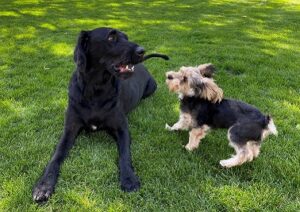With my long-overdue first blog post of 2020, I’ve decided not to write about the global pandemic or anything directly related to the current economic, social, and political unrest in the country. I do care about public health, social justice, and engaging in dialogue to solve our problems. But right now I’m fatigued by the never-ending news cycle, the divisiveness, and the cynicism of the present moment. I want to explore other things.

I’ve written before about our family Labradoodle, noting how he used to chew up the sprinklers and wolf down an entire plate of brownies delivered to us by the neighbors. Mako has long outgrown the puppy stage, although he still barks up a storm whenever the doorbell rings, even if the visitor turns out to be a familiar-smelling family member. He also bolts out an open door if he senses another dog nearby. But on the whole, he’s a trusted and beloved family pet. Always a peacemaker, Mako dashes over and blocks anyone who’s raising their voice or behaving aggressively.
Wally Conron, the Australian dog breeder credited for inventing the Labradoodle, has in recent years expressed regret over creating a “Frankenstein’s monster.” He’s referring mostly to the unscrupulous breeders who create puppy mills and carelessly propagate mental or physical health problems in the breed. The Labradoodle was originally designed for people who were allergic to Labrador Retrievers but needed a good service dog. With the proper training, our Mako could certainly fill such a need. Since he’s just a first generation Labradoodle (his father was a poodle and his mother was a lab), he requires frequent haircuts to keep shedding to a minimum. But we think he’s very nearly the perfect pet.
Over the summer, our nine-year-old daughter begged us to get another dog. She argued that Mako needed a companion, and we finally relented. Of course her real reason was the irresistible enchantment of owning a cute puppy. We ultimately decided on and paid too much for a Yorkshire Terrier / Poodle / Cavalier King Charles Spaniel mix.
As a typical puppy who nips at your heals, chews up your socks, and has frequent accidents in the house, Togo quickly left the honeymoon phase, convincing our daughter that what she really wanted was a kitten. To her credit, she hasn’t given up on her puppy training, and Togo will now sit, lay, and shake both paws on a consistent basis. He’s also a good lap dog, willing to quietly cuddle on the couch or daintily chew on a toy while we watch a movie. Togo still won’t obediently come when he’s caught up in something more interesting outside. And he’s often a little too feisty with our two-year-old granddaughters. But his biggest problem is that he doesn’t get along with Mako.
As they enter their third month together, Togo still spends a good part of each day leaping up on his older brother, biting his ears, back legs, and anything else he can sink his teeth into. Mako moans and groans as he firmly yet gently pins Togo on his little back again and again, asserting his dominance as the Alpha male. But Togo doesn’t quit, repeating the same pattern of behavior day after day and night after night. Of course a lot of this could be written off to playfulness or the dog-equivalent of sibling rivalry. And it has never turned into a real dogfight. But it’s almost as hard for me to watch as the first presidential debate of 2020, which by some curious coincidence is taking place this evening as I write. As far as I know, very little blood has been drawn and both dogs remain healthy. But just about every chance he gets, Mako removes himself from the presence of his annoying little brother. If Togo is outside, Mako prefers staying inside.
So what’s going on with these two dogs who don’t seem to like each other very much? With a little research, I discovered some helpful historical insights about Yorkshire Terriers. Before they became popular as upper class companion dogs in the late 19th century, Yorkies were used as “ratters,” small dogs that miners or mill workers would carry with them to control rats and other rodents. Yorkies were also used to hunt fox, badgers, and other wild animals in the fields. As they cornered burrowing animals who were defending their dens, Yorkies displayed the pugnacious and courageous qualities of hunting dogs.
Perhaps this historical background can help me come to grips with the natural instincts behind dysfunctional doggie relationships. I’m hopeful that Togo and Mako will learn to like each other and become the friendly companions that my daughter had envisioned. Only time will tell if they’re capable of living in peace and harmony, and I’ll have to report back on their progress in a couple of years. In the meantime, I’d prefer not watching two dogs who seem to be vying to become the pack leader. For that matter, I’d also prefer not watching presidential debates.

